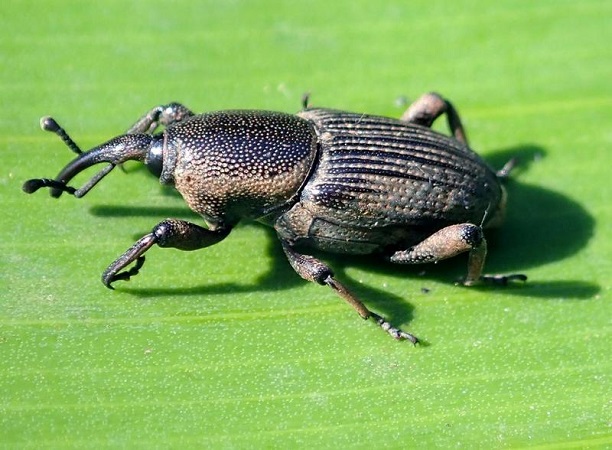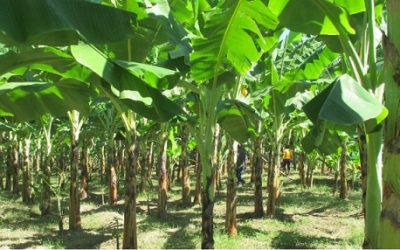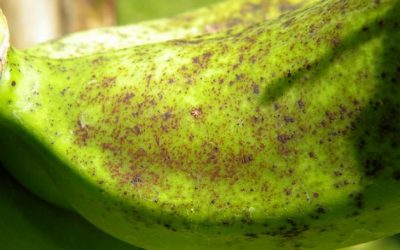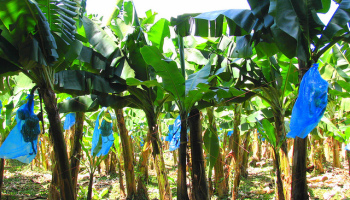How to handle Banana weevils in your Banana plantation.

Banana weevils are insects that thrive by eating parts of the banana plant such as the roots, corm, stem, leaves and any other part. When they do that, they weaken the plant as they take away nutrients thus leading to significantly reduced yield, toppling or falling off of the plants and damage to the plantation. They therefore need to be better managed to ensure that we have healthy plantations.
Banana weevil are one of the most devastating well known pest. It lays its eggs in the corm and when they hatch into larvae, which look like large maggots, they eat the corm and lower part of the stem.
They bore holes in the whole foundation of the plant. In this process, they take vital nutrients which would otherwise make the plant stronger and yield better. The larvae mature into adults which then mate and lay more eggs.
Weevil infestation in young plants causes stunting, disruption and delay of fruiting, and sometimes leads to plant death. Heavily infested plants produce small bunches, and have reduced resistance to drought and strong winds which makes them to topple.
The banana weevil causes more damage to the cooking bananas than the beer bananas.
Poor management such as no desuckering and no pruning encourages weevil attack and damage. Control methods include management of the sites where the weevil lays her eggs. These methods requires no extra input.
1. Use of clean planting material: Disease- and pest-free tissue culture seedlings minimises the spread of weevils, which are mainly carried to new sites with infested suckers.
Clean suckers are obtained from tissue culture nursery operators, companies or agents. Other practices using conventional suckers have been proven to be ineffective. This is especially when corms to be used as planting materials are already infected and if methods of disinfecting them have not been done properly.
2. Good husbandry: This involves weeding, de-suckering, pruning, manuring and mulching, which produce vigorous plants that are more tolerant to weevil damage.
3. Destruction of post-harvest residues: Removal and splitting of harvested stems into small strips and drying them reduces hiding and breeding sites for the weevil. It also exposes weevil eggs and larvae to desiccation and death.
4. Trapping: Two types of traps, pseudo stem and disc-on-stump, are used. The first is made from pseudo stem pieces split into halves and placed against a banana plant with split surface on the ground.
The second, on the other hand, are made by cutting harvested stump, 15-25 cm above ground level and then placing a pseudo stem sheath or banana leaves on top of the stump. The weevils attracted to these traps are collected and destroyed. Traps remain effective for about one or two weeks and are renewed whenever ample supp1y of pseudo stem pieces are available.
5. Use of mixtures of ash, urine and insecticidal plants: Traditionally, farmers have used ash in banana fields to enhance soil nutrients and control weevils. Farmers are now using mixtures prepared by adding various levels of ash, urine, tobacco, capsicum, phytolacca and other weed species.
The method and rates of application vary from farmer to farmer. But the most common one is use of a 14-day fermented mixture at one to two cups (500 ml-1,000 ml) per banana stool. While the practice is recommended and encouraged, its field efficacy, economics and scalability are still unclear.
Apart from cultural practices, chemical control can also be employed. This can be done at planting if one is planting corms or traditional suckers. In case one is using tissue culture seedlings, there is no need to apply chemicals at planting because the seedlings are disease and pest free.
In case one is using conventional suckers, an insecticide such as Furadan, Pimicid, Mocap and Dursban should be systematically applied around the sucker in the planting hole.
In the case of established plantation, the insecticides should be applied to the soil around on the base of the banana stool. The chemicals can also be applied on the traps to kill the weevils that have already been attracted to the traps. It is extremely important for a farmer to seek advice from experts before applying such chemicals for weevil control.


